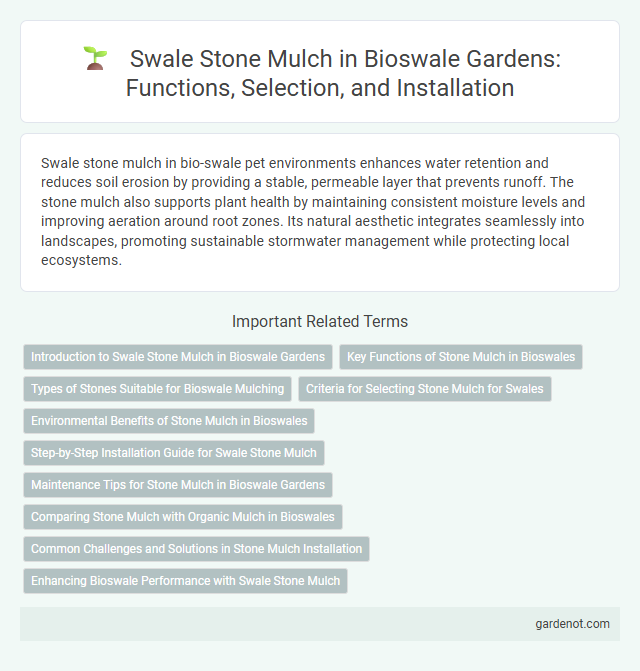Swale stone mulch in bio-swale pet environments enhances water retention and reduces soil erosion by providing a stable, permeable layer that prevents runoff. The stone mulch also supports plant health by maintaining consistent moisture levels and improving aeration around root zones. Its natural aesthetic integrates seamlessly into landscapes, promoting sustainable stormwater management while protecting local ecosystems.
Introduction to Swale Stone Mulch in Bioswale Gardens
Swale stone mulch enhances bioswale gardens by improving water infiltration and reducing soil erosion through porous stone layers. This mulch type supports plant health by maintaining moisture levels and preventing weed growth while allowing nutrient-rich runoff to percolate effectively. Utilizing swale stone mulch optimizes bioswale functionality by balancing drainage and filtration, promoting sustainable urban water management.
Key Functions of Stone Mulch in Bioswales
Stone mulch in bioswales functions primarily to enhance water infiltration by reducing surface runoff and promoting soil permeability. It suppresses weed growth, minimizing competition for moisture and nutrients while protecting soil structure from erosion caused by heavy rainfall. Additionally, stone mulch aids in temperature regulation around plant roots, improving overall bioswale health and vegetation resilience.
Types of Stones Suitable for Bioswale Mulching
Swale stone mulch typically includes river rocks, pea gravel, and crushed granite, all suitable for bioswale mulching due to their ability to improve drainage and reduce soil erosion. River rocks offer smooth surfaces that facilitate water flow, while pea gravel provides excellent permeability, enhancing water infiltration in the swale system. Crushed granite's angular shape helps stabilize soil and maintain mulch structure, making it ideal for long-term bioswale maintenance.
Criteria for Selecting Stone Mulch for Swales
Swale stone mulch selection centers on permeability, durability, and particle size to ensure efficient water infiltration and prevent erosion. Opt for angular stones sized between 0.5 to 2 inches for optimal water flow and stability within bio-swales. The chosen stone must be chemically inert to avoid soil contamination and support plant health in stormwater management systems.
Environmental Benefits of Stone Mulch in Bioswales
Stone mulch in bioswales enhances soil moisture retention by reducing evaporation, which supports deeper root growth and plant health. It minimizes erosion and surface runoff, allowing improved filtration of stormwater and reducing pollutant transport into waterways. The durable, inorganic nature of stone mulch also prevents weed growth without chemicals, contributing to a sustainable and low-maintenance bioswale system.
Step-by-Step Installation Guide for Swale Stone Mulch
Swale stone mulch installation begins with excavating a shallow trench along the swale's contour line to ensure proper water flow and infiltration. Next, place a permeable landscape fabric inside the trench to prevent weed growth while allowing moisture to reach the soil. Finally, fill the swale with a 2-3 inch layer of clean, angular stone mulch, carefully leveling the surface to maintain drainage efficiency and support native plant growth.
Maintenance Tips for Stone Mulch in Bioswale Gardens
Swale stone mulch requires regular inspection to prevent debris buildup and ensure proper water infiltration in bioswale gardens. Periodic removal of sediment and organic matter helps maintain permeability, while replenishing stone mulch every 1-2 years preserves its effectiveness in erosion control and weed suppression. Using a layer depth of 2-4 inches balances moisture retention and drainage, optimizing bioswale performance.
Comparing Stone Mulch with Organic Mulch in Bioswales
Swale stone mulch offers superior drainage and long-term durability compared to organic mulch in bioswales, reducing erosion and preventing clogging. Unlike organic mulch, which decomposes and requires frequent replacement, stone mulch maintains soil structure and promotes efficient stormwater infiltration. Its inert nature minimizes nutrient leaching, helping to maintain water quality and support sustainable bioswale performance.
Common Challenges and Solutions in Stone Mulch Installation
Swale stone mulch installation often faces challenges such as improper drainage, weed growth, and stone displacement during heavy rainfall. To counter these issues, using geotextile fabric beneath the stones enhances stability and prevents weed infiltration, while graded stone sizes improve water permeability and reduce erosion. Proper edging and regular maintenance ensure the mulch remains effective in bio-swale environments.
Enhancing Bioswale Performance with Swale Stone Mulch
Swale stone mulch improves bioswale performance by enhancing water infiltration and reducing surface runoff, which minimizes erosion and sediment buildup. The porous nature of the stone mulch promotes aerobic soil conditions, supporting beneficial microbial activity for contaminant breakdown. Its durability and low maintenance needs ensure long-term effectiveness in stormwater management within bioswale systems.
Swale stone mulch Infographic

 gardenot.com
gardenot.com